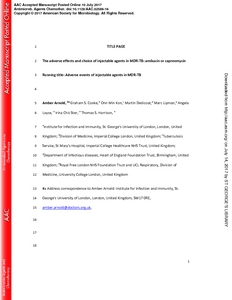Arnold, A; Cooke, GS; Kon, OM; Dedicoat, M; Lipman, M; Loyse, A; Ster, IC; Harrison, TS
(2017)
Adverse Effects and Choice between the Injectable Agents Amikacin and Capreomycin in Multidrug-Resistant Tuberculosis.
Antimicrob Agents Chemother, 61 (9).
e02586-16.
ISSN 1098-6596
https://doi.org/10.1128/AAC.02586-16
SGUL Authors: Harrison, Thomas Stephen Chis Ster, Delizia Irina
![[img]](http://sgultest.da.ulcc.ac.uk/108981/1.hassmallThumbnailVersion/Antimicrob.%20Agents%20Chemother.-2017-Arnold-AAC.02586-16.pdf)  Preview |
|
PDF
Accepted Version
Available under License ["licenses_description_publisher" not defined].
Download (1MB)
| Preview
|
Abstract
Background: The prolonged use of injectable agents in an MDR-TB regimen is recommended by the WHO despite association with ototoxicity and nephrotoxicity.Objective: We undertook this study to look at the relative adverse effects of capreomycin and amikacin.Methods: We reviewed the case notes of 100 consecutive patients treated at 4 MDR-TB treatment centres in the UK.Results: The median total duration of treatment with an injectable agent was 178 (IQR 109-192, n=73) days for those with MDR-TB, 179 (104-192, n=12) days for those with MDR-TB plus fluoroquinolone resistance and 558 (324-735, n=8) days for those with XDR-TB. Injectable use was longer for those started with capreomycin at 183 (IQR 123-197) days compared to 119 (IQR 83-177) days with amikacin (p=0.002). Excluding XDR-TB, 51 (51/85, 60%) patients were treated with an injectable for over 6 months and 12 (12/85, 14%) for over 8 months. 40 % of all patients discontinued the injectable due to hearing loss. 55% of patients experienced ototoxicity: 5 times (hazard ratio (HR) 5.2, CI 1.2-22.6, p=0.03) more likely in those started on amikacin compared to treatment with capreomycin only. Amikacin was associated with less hypokalemia than capreomycin (Odds ratios: 0.28 (0.11-0.72)), with 5 (5/37, 14%) patients stopping capreomycin due to recurrent electrolyte loss. There was no difference in the number experiencing a creatinine rise of > 1.5 times baseline.Conclusion: Hearing loss is frequent in this cohort, though significantly lower in those starting capreomycin which should be given greater consideration as a first line agent.
Statistics
Item downloaded times since 14 Jul 2017.
Actions (login required)
 |
Edit Item |



